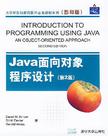Java面向对象程序设计
出版时间:2004-10 出版社:清华大学出版社 作者:(美)阿诺(Arnow,D.M.),(美)德克斯特(Dexter,S.),(美)卫斯(Weiss,G.)等著 页数:680
Tag标签:无
内容概要
本书是由在大学任教的教授写给选修编程课程学生的基础教材,并不要求学生具备编程背景。本书从第一章开始就引入了对象、类、消息等基本概念,自始至终从面向对象的角度使读者建立起编程的坚实基础。本书将重点放在软件开发过程的讲解,注重实用性与可操作性。“图形用户界面(GUI)设计实例”和“Java应用技巧”两个部分贯穿全书每一章,以加强读者对核心概念的理解。本书重点介绍了Java语言及其类库,以及大量编程技巧和算法,使读者能够通过学习本教材具备用软件解决实际问题的能力。 本书内容丰富,范例程序详实,适合作为Java程序设计的学习用书。
作者简介
作者:(美国)阿诺(Arnow David M.) (美国)德克斯特 (Dexter Scott) (美国)卫斯 (Weiss Gerald)
书籍目录
CHAPTER 1 Jumping into Java 1.1 Computers and Programs 1.2 Programs and Models 1.3 Objects,Classes,and Messages 1.4 Our First Object:A PrintStream 1.5 Sending a Message to the System out Object 1.6 A Java Program 1.7 Mechanics 1.8 Time Summary Key Terms Questions for Review Exercises Introduction:Web Pages,HTML,and AppletsCHAPTER 2 Sending Messages and Performing Operations 2.1 Introduction 2.2 Using PrintStream Objects References,Methods,and Messages 2.3 The String Class 2.4 Methods,Arguments,and Return Values 2.5 Reference Variables Variables and Assignment 2.6 Imperative Programming:Doing the Work 2.7 Using String Methods 2.8 Imperative Programming:Simple Conditionals Summary Key Terms Questions for Review Exercises Painting and Positioning GraphicsCHAPTER 3 Working with Objects and Primitive Types 3.1 Introduction 3.2 Creating Objects Origins of Objects 3.3 Imperative Programming:The boolean Type 3.4 Working with Objects 3.5 Dates and Calendars 3.6 Imperative Programming:Other Integer Types 3.7 BigInteger Packages and the import Statement 3.8 Introduction to Input 3.9 The File Input Process 3.10 Keyboard Input 3.11 File Output 3.12 Network Computing:An Introduction Java Documentation Summary Key Terms Questions for Review Exercises Toward AnimationCHAPTER 4 Defining Classes 4.1 Introduction 4.2 Class Definition:Methods 4.3 Class Definition:Instance Variables 4.4 More on Methods:Return Values 4.5 Imperative Programming:Finding the Minimum Variables,Declarations,and the return Statement 4.6 Still More on Methods:Parameters 4.7 State and Behavior 4.8 Class Definition:Putting It All Together Declarations,Access,and Objects Summary Key Terms Questions for Review Exercises A Simple AnimationCHAPTER 5 Advanced Class Definition 5.1 Customizing New Objects:Constructors Constructors,Initializers,and Overloading 5.2 Example:A Name Class 5.3 Providing Class Behaviors Static Methods 5.4 Tracking Class-Wide Information:Static Variables 5.5 Defining Constant Values:final Working with Objects 5.6 Input Methods Revisited:Testing for End of Input Summary Key Terms Questions for Review Exercises Creating Controls and InteractionCHAPTER 6 Inside the Method:Imperative Programming 6.1 Introduction 6.2 A Metric Conversion Class float,double,and the for Statement 6.3 Approximating the Value of π 6.4 Cascaded and Compound Conditional Statements Logical Operators and Conditional Statements Summary Key Terms Questions for Review Exercises More on InteractionCHAPTER 7 Designing Classes 7.1 Introduction 7.2 Designing Classes-An Overview 7.3 The Counter Class Revisited 7.4 An Automated Teller Machine 7.5 Dispatching Repairpeople:An Example Summary Key Terms Questions for Review Exercises Multiple Controls:Layout and Event HandlingCHAPTER 8 Verifying Object Behavior 8.1 Introduction 8.2 Categories of Errors Java's Assertion Facility 8.3 Test Drivers 8.4 Automatic Testing 8.5 What to Test and How to Test It 8.6 Debugging Techniques Summary Key Terms Questions for Review Exercises Separating Display and ControlCHAPTER 9 Working with Multiple Objects 9.1 Introduction 9.2 Processing Multiple Objects 9.3 Loop Patterns 9.4 The Impact of Loops on Testing 9.5 A Telephone Book 9.6 Maintaining Multiple Values 9.7 Vector-A Simple Collection Class 9.8 Traversing Vectors Using for Loops 9.9 Revisiting the TelephoneBook Class Primitive Types and Collections:Revisiting the Wrapper Classes 9.10 An Example-Determining a Student's Relative Performance 9.11 Another Vector Application object Methods 9.12 Introducing Arrays 9.13 Vectors and Arrays 9.14 Coin Flipping with Arrays Summary Key Terms Questions for Review Exercises Positioning TextCHAPTER 10 Designing Iteration 10.1 Introduction 10.2 Designing Loops Two Loop Statements 10.3 Another Simple Example 10.4 Revisiting Loop Patterns 10.5 Variations on the Repairperson Loop 10.6 Totaling a Bank's Accounts 10.7 More Loop Patterns:Counters,Accumulators,and Extremes 10.8 Iterating Through Arrays Short Circuits,break,and continue 10.9 A Loop Design Strategy:Refining an Imperfect Solution 10.10 Example:The LOGO Turtle Summary Key Terms Questions for Review Exercises More Text ManipulationCHAPTER 11 Maintaining Collections of Objects 11.1 Overview 11.2 Searching 11.3 Binary Search 11.4 Finding the Index of an Extreme 11.5 Sorting 11.6 Searching Files 11.7 Threads:Computing in Parallel 11.8 Threads:A Parallel File Search Summary Key Terms Questions for Review Exercises ThreadsCHAPTER 12 Extending Class Behavior 12.1 Introduction 12.2 Extending Classes-Inheritance I 12.3 A Better BufferedReader 12.4 Sdding State to the Subclass-Accessing the Superclass's State 12.5 Revisiting the Name Class-Adding Additional State Inheritance 12.6 Overriding Methods Polymorphism 12.7 Factoring Out Common Behavior-Inheritance II 12.8 Abstract Methods and Classes 12.9 Specifying Common Behavior-Interfaces 12.10 A Generic Sorting Method Summary Key Terms Questions for Review Exercises Exploring the Abstract Window Toolkit of the Java Class HierarchyCHAPTER 13 Exceptions 13.1 Expect the Unexpected 13.2 Encountering the Unexpected The Exception Class 13.3 Handling the Unexpected 13.4 Responsibility for the Unexpected 13.5 Exceptions Are Not Always Errors Summary Key Terms Questions for Review Exercises The Model-View-Controller(MVC)ParadigmCHAPTER 14 Recursion 14.1 Introduction 14.2 Example:Exponentiation 14.3 How to Design a Recursive Method 14.4 Recursive Methods:Under the Hood 14.5 Recursion with Vectors,Arrays,and Strings 14.6 Permutations 14.7 Towers of Hanoi 14.8 Recursion and Iteration Summary Key Terms Questions for Review Exercises Towers of Hanoi AppletCHAPTER 15 Client-Server Computing 15.1 Clients and Servers 15.2 Internet Communiction 15.3 Client-Server Computing 15.4 Some Simple Client Classes Summary Key Terms Questions for Review Exercises Swing APPENDIX A GlossaryAPPENDIX B Three Java EnvironmentsAPPENDIX C AWIOAPPENDIX D Traversing Collections Using Enumerations
图书封面
图书标签Tags
无
评论、评分、阅读与下载
用户评论 (总计2条)
- 看完后英语水平肯定会有所提升!
- 这本书所举例子很形象,让人容易理解面向对象到底是什么,而且每章的后面都有重要概念的总结,是本不错的JAVA入门书。
